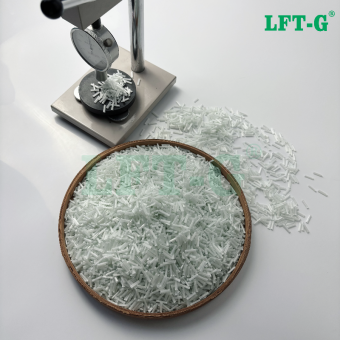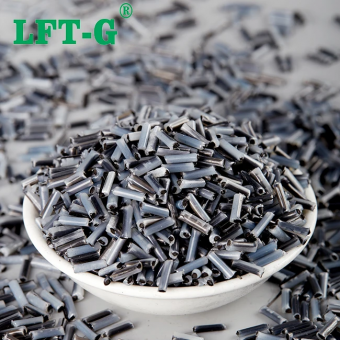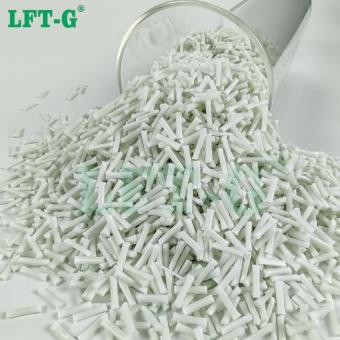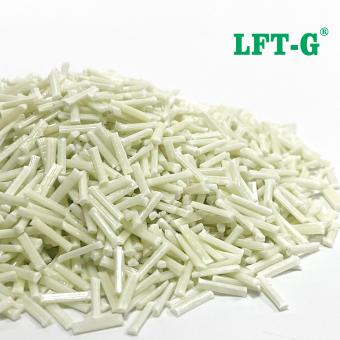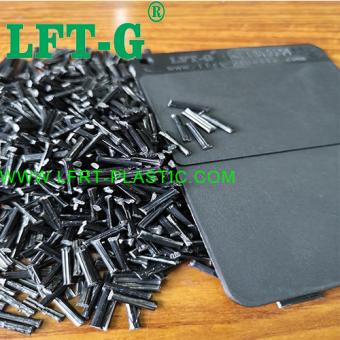-
Nylon 66 Hochleistungs-PA66-Langkohlefaser-Verbundwerkstoffe für die Luft- und RaumfahrtWhat is PA66 plastic? Polyadipyladipylenediamine, commonly known as nylon -66, is a thermoplastic resin, generally made from adiponic acid and hexadipamine condensation. Insoluble in general solvents, only soluble in m-cresol, etc. High mechanical strength and hardness, rigidity. It can be used as engineering plastics, mechanical accessories such as gears, lubricating bearings, instead of non-ferrous metal materials to make machine shells, automotive engine blades, and can also be used to make synthetic fibers. PA66 plastic raw material is translucent or opaque opalescent crystalline polymer, with plasticity. Density 1.15g/cm3. Melting point 252℃. Embrittlement temperature -30℃. Thermal decomposition temperature is greater than 350℃. Continuous heat resistance 80-120℃, balanced water absorption rate of 2.5%. Resistant to acid, alkali, most aqueous inorganic salts, alkyl halides, hydrocarbons, esters, ketones and other corrosion, but easy to phenol, formic acid and other polar solvents. It has excellent wear resistance, self lubricity and high mechanical strength. But the water absorption is larger, so the dimensional stability is poor. What is Long Carbon Fiber? In the modified engineering plastics industry, long fiber reinforced composite material refers to long carbon fiber, long glass fiber, aramid fiber or basalt fiber and polymer matrix, through a series of special modification methods to produce composite materials. The biggest characteristic of long fiber composites is that they have superior properties that the original materials do not have. If they are classified according to the length of the added reinforcement materials, they can be divided into long fiber, short fiber and continuous fiber composites. As mentioned in the beginning, long carbon fiber composite material is a kind of long fiber reinforced composite material, which is a new fiber material with high strength and high modulus fiber. LCF carbon fiber composite exhibits high strength along the fiber axis, and has the characteristics of high strength and light weight. It has the comprehensive mechanical properties such as density, specific strength and specific modulus that are incomparable to other materials. It is a new material with excellent mechanical properties and many special functions. What are the properties of Long Carbon fiber? Corrosion resistance: LCF carbon fiber composite material has good corrosion resistance, can adapt to harsh working environment; Uv resistance: strong ability to resist UV, products by UV damage problem is small; Wear resistance and impact resistance: compared with the general material advantage is more obvious; Low density: lower than the density of many metal materials, can achieve the purpose of lightweight; Other properties: such as reducing warpage, improving rigidity, impact modification, increasing toughness, electrical conductivity and so on. Compared with glass fiber, LCF carbon fiber composite has higher strength, higher rigidity, lower weight, and excellent electrical conductivity. What is the application fileds of PA66-LCF? 1. Military industry LFT long carbon fiber composite has very high specific strength and stiffness, and has the characteristics of corrosion resistance, fatigue resistance, high temperature resistance and low thermal expansion coefficient, etc. LCF carbon fiber composite is widely used in rocket, missile, military aircraft, personal protection and other military fields at home and abroad. Compared with conventional materials, long carbon fiber composites allow for continuous improvements in the performance of military equipment, such as reducing the weight of warships by 20 to 40 percent. At the same time, LCF carbon fiber composite material can overcome the metal material is easy to be corroded, easy to fatigue and other shortcomings, improve and enhance the durability of military products. Currently, more than 40 percent of LCF carbon fiber composite materials are used in some advanced military helicopters, and even more in unmanned aerial vehicles. In addition to aircraft, Marine warships also appear long carbon fiber composite material figure, because long carbon fiber composite material can withstand the corrosion of seawater and a variety of chemical impurities, has a long service life, more durable than steel warships, lower maintenance costs, has become an important strategic material for the development of modern defense military weapons and equipment. 2. Home appliance field LCF carbon fiber composite material has low density, good chemical resistance, excellent performance and other characteristics, has gradually become the home appliance industry's preferred modified engineering plastics, its usage accounts for about 30% and is on the rise. Moreover, home appliances are more and more intelligent and personalized, and the modified performance requirements of materials are higher. So it's no surprise that long carbon fiber composites are chosen by th...
- Marke LFT-G
- Polyadipyladipdiamin
- Verbundwerkstoff
- Thermoplastisches Harz
- Synthetische Faser
- Stattdessen Medaillenmaterial
Tags :
-
Xiamen LFT Polyamid 66 Hochleistungs-PA66-Langkohlefaser-Verbundwerkstoffe für die Luft- und RaumfahrtWas ist PA66-Kunststoff? Polyadipyladipylendiamin, allgemein bekannt als Nylon-66, ist ein thermoplastisches Harz, das im Allgemeinen aus der Kondensation von Adiponsäure und Hexadipamin hergestellt wird. In allgemeinen Lösungsmitteln unlöslich, nur in m-Kresol usw. löslich. Hohe mechanische Festigkeit und Härte, Steifigkeit. Es kann als technischer Kunststoff, mechanisches Zubehör wie Zahnräder und Schmierlager anstelle von Nichteisenmetallmaterialien zur Herstellung von Maschinengehäusen und Motorschaufeln für Kraftfahrzeuge verwendet werden und kann auch zur Herstellung synthetischer Fasern verwendet werden. Der Kunststoffrohstoff PA66 ist ein durchscheinendes oder undurchsichtiges opaleszierendes kristallines Polymer mit Plastizität. Dichte 1,15 g/cm3. Schmelzpunkt 252℃. Versprödungstemperatur -30℃. Die Temperatur der thermischen Zersetzung liegt über 350℃. Kontinuierliche Hitzebeständigkeit 80–120 °C, ausgewogene Wasseraufnahmerate von 2,5 %. Beständig gegen Säure, Alkali, die meisten wässrigen anorganischen Salze, Alkylhalogenide, Kohlenwasserstoffe, Ester, Ketone und andere Korrosion, aber leicht gegen Phenol, Ameisensäure und andere polare Lösungsmittel. Es verfügt über eine ausgezeichnete Verschleißfestigkeit, Selbstschmierfähigkeit und hohe mechanische Festigkeit. Allerdings ist die Wasseraufnahme größer, sodass die Dimensionsstabilität schlecht ist. Was ist eine lange Carbonfaser? In der Industrie für modifizierte technische Kunststoffe bezieht sich der Begriff langfaserverstärkter Verbundwerkstoff auf lange Kohlenstofffasern, lange Glasfasern, Aramidfasern oder Basaltfasern und eine Polymermatrix, die durch eine Reihe spezieller Modifikationsmethoden zur Herstellung von Verbundwerkstoffen verwendet werden. Das größte Merkmal von Langfaserverbundwerkstoffen besteht darin, dass sie über überlegene Eigenschaften verfügen, die die Originalmaterialien nicht haben. Werden sie nach der Länge der zugefügten Verstärkungsmaterialien klassifiziert, können sie in Langfaser-, Kurzfaser- und Endlosfaserverbundwerkstoffe unterteilt werden. Wie eingangs erwähnt, handelt es sich bei Langkohlefaserverbundwerkstoffen um eine Art langfaserverstärkter Verbundwerkstoff, bei dem es sich um ein neues Fasermaterial mit hoher Festigkeit und hohem Modul handelt. Der LCF-Kohlenstofffaserverbund weist eine hohe Festigkeit entlang der Faserachse auf und zeichnet sich durch hohe Festigkeit und geringes Gewicht aus. Es verfügt über umfassende mechanische Eigenschaften wie Dichte, spezifische Festigkeit und spezifisches Modul, die mit anderen Materialien nicht zu vergleichen sind. Es handelt sich um einen neuen Werkstoff mit hervorragenden mechanischen Eigenschaften und vielen Sonderfunktionen. Was sind die Eigenschaften von Long Carbon-Fasern? Korrosionsbeständigkeit: LCF-Kohlefaserverbundwerkstoff weist eine gute Korrosionsbeständigkeit auf und kann sich an raue Arbeitsumgebungen anpassen; UV-Beständigkeit: Starke UV-Beständigkeit, das Problem der UV-Schädigung von Produkten ist gering; Verschleißfestigkeit und Schlagfestigkeit: Im Vergleich zum allgemeinen Material ist der Vorteil offensichtlicher; Geringe Dichte: niedriger als die Dichte vieler Metallmaterialien, kann den Zweck des Leichtgewichts erreichen; Weitere Eigenschaften: Reduzierung des Verzugs, Verbesserung der Steifigkeit, Schlagzähigkeit, Erhöhung der Zähigkeit, elektrische Leitfähigkeit usw. Im Vergleich zu Glasfasern weist LCF-Kohlenstofffaserverbundwerkstoff eine höhere Festigkeit, höhere Steifigkeit, ein geringeres Gewicht und eine hervorragende elektrische Leitfähigkeit auf. Was sind die Anwendungsbereiche von PA66-LCF? 1. Militärindustrie LFT-Langkohlenstofffaserverbundwerkstoff weist eine sehr hohe spezifische Festigkeit und Steifigkeit auf und zeichnet sich durch Korrosionsbeständigkeit, Ermüdungsbeständigkeit, hohe Temperaturbeständigkeit und niedrigen Wärmeausdehnungskoeffizienten usw. aus. LCF-Kohlenstofffaserverbundwerkstoff wird häufig in Raketen, Flugkörpern und Militärflugzeugen verwendet. Personenschutz und andere militärische Bereiche im In- und Ausland. Im Vergleich zu herkömmlichen Materialien ermöglichen Verbundwerkstoffe aus langen Kohlenstofffasern eine kontinuierliche Verbesserung der Leistung militärischer Ausrüstung, beispielsweise eine Gewichtsreduzierung von Kriegsschiffen um 20 bis 40 Prozent. Gleichzeitig kann LCF-Kohlenstofffaserverbundwerkstoff die leicht korrodierenden, leicht ermüdbaren und anderen Mängel des Metallmaterials überwinden und die Haltbarkeit von Militärprodukten verbessern und verbessern. Derzeit werden mehr als 40 Prozent der LCF-Kohlefaserverbundwerkstoffe in einigen fortschrittlichen Militärhubschraubern und sogar noch mehr in unbemannten Luftfahrzeugen verwendet. Neben Flugzeugen erscheinen auch Marine-Kriegsschiffe als lange Kohlefaser-Verbundwerkstoffe, da lange Kohlefaser-Verbundwerkstoffe der Korrosion von Meerwasser und einer Vielzahl chemischer Verunreinigungen standhalten können, eine lange Lebensda...mehr sehen

 Email
Email Deutsch
Deutsch English
English français
français русский
русский italiano
italiano español
español português
português العربية
العربية 日本語
日本語 한국의
한국의 中文
中文




